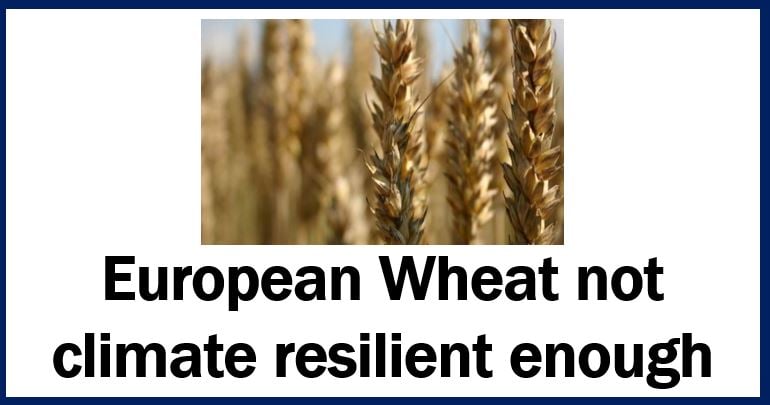European wheat lacks climate resistance, says an international team of European scientists. European farmers must take a new course to ensure climate-resilience of vital crops such as wheat.
Farmers’ problems are not only global warming but also climate change. In other words, not only is our climate warming but it is also becoming more extreme and variable. Our increasingly unpredictable weather with more extreme weather events is a serious threat to food security.
Food security will weaken if vital crops such as wheat are not climate resistant enough and if we do not prepare ourselves properly.
The research team wrote about their study and findings in the Proceedings of the National Academy of Sciences (citation below).
The authors found that current cultivar selection practices and breeding programs are inadequate. Specifically, they do not provide the necessary resilience to climate change. A cultivar is a plant that has been selected from a naturally occurring species. It is bred to maintain or enhance a specific set of desirable characteristics.
They also found that in Europe, response diversity of wheat on farmers’ fields has worsened over the past five to 15 years.
The researchers say that more extreme local weather conditions will lead to lower wheat yields and greater yield variability. Greater weather variability will also undermine wheat yields.

Decreased and more variable wheat yields
Professor Jørgen E. Olesen, who works at the Department of Agroecology at Aarhus University, said:
“Needless to say, decreased yields are not conducive to food security, but higher yield variability also poses problems. It can lead to a market with greater speculation and price volatility.”
“This may threaten stable access to food by the poor, which in turn can enhance political instability and migration.”
Decreasing response diversity variation
The research team bases its assessment on thousands of yield observations of wheat cultivars in nine different European nations. The observations focused on how different cultivars responded to weather conditions.
They identified wheat response diversity variation on farmers’ fields and demonstrated the relation to climate resilience.
The yield responses of all wheat cultivars to weather events were fairly similar within central and northern Europe. They were also similar within southern European nations. In southern Europe, the similarity was marked with regard to durum wheat.
Serious gaps in wheat resilience
Across the whole of Europe, there were serious gaps in wheat resilience, especially regarding yield performance under heavy rain.
Extreme weather events at vulnerable times during the growing season can damage yields significantly. Extreme heat, drought, torrential rain, and cold snaps, for example, are extreme weather events.
Just a few days of exposure to water-logging can damage wheat yields. The same applies to wet weather that favors disease. A factor that limits the adaptation of wheat to climate change in Europe appears to be heat stress rather than drought sensitivity.
Current approach is inadequate
Tailoring genotypes to the most likely long-term change is the dominant approach today of adapting crops to climate change. The authors say that the approach is probably insufficient.
According to an Aarhus University press release:
“The capacity of a single crop variety to maintain good yield performance under climatic variability and extremes is limited, but diversity in responses to critical weather events can effectively enhance climate resilience.”
“Therefore, a set of cultivars with diverse responses to critical weather conditions is prerequisite to promoting crop climate resilience.”
People need to be made aware of the need for climate resilience of staple food crops such as wheat, the authors stressed. Greater awareness would lead to more incentives, breeding programs, and regulation.
What is climate change?
Climate change refers to the long-term shift in global weather patterns as well as average temperatures. When average temperatures are rising, we can also refer to it as global warming. The term ‘climate change’ also includes more frequent occurrences of extreme weather events.
Citation
“Decline in climate resilience of European wheat,” Helena Kahiluoto, Janne Kaseva, Jan Balek, Jørgen E. Olesen, Margarita Ruiz-Ramos, Anne Gobin, Kurt Christian Kersebaum, Jozef Takáč, Francoise Ruget, Roberto Ferrise, Pavol Bezak, Gemma Capellades, Camilla Dibari, Hanna Mäkinen, Claas Nendel, Domenico Ventrella, Alfredo Rodríguez, Marco Bindi, and Mirek Trnka. Proceedings of the National Academy of Sciences, Published ahead of print December 24, 2018. DOI: https://doi.org/10.1073/pnas.1804387115.

